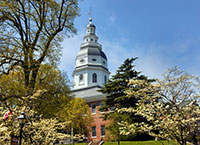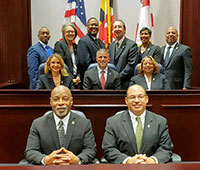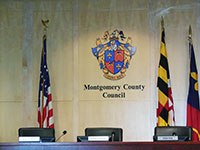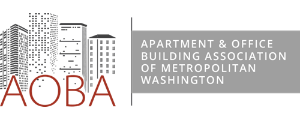Maryland At Issue - August 2019
State
Maryland General Assembly Considers Key Rental Policies During Recess
 While Maryland lawmakers conducted most of their state business during the 90-day legislative session, two key proposals were directed to summer study for deeper analysis. The Rent Transparency Act (SB 366/HB 588) and a Definition of Rent bill (SB 941/ HB 473) were referred to “summer study” and AOBA members should expect legislators to revisit these proposals during the 2020 Legislative Session.
While Maryland lawmakers conducted most of their state business during the 90-day legislative session, two key proposals were directed to summer study for deeper analysis. The Rent Transparency Act (SB 366/HB 588) and a Definition of Rent bill (SB 941/ HB 473) were referred to “summer study” and AOBA members should expect legislators to revisit these proposals during the 2020 Legislative Session.
AOBA members may remember the Rent Transparency Act, which sought to confirm a recent Court of Appeals’ ruling and mandate transparency in leases by requiring housing providers to make it clear that utility fees are part of a tenant’s rent obligation. This bill seeks to specifically define “rent” in Maryland statute and would expand the definition of rent by allowing a housing provider who uses a written lease “to collect as rent any fee or charge owed to the landlord” as outlined in the lease.
Another proposal seeking to define rent in Maryland statute, SB 941/HB 473, intended to define “rent” more narrowly as “the fixed periodic sum for use and possession of the leased premises and does not include any additional payments due from the tenant to the landlord under the lease”.
The Senate sponsors of these bills have tasked an AOBA partner, the Maryland Multifamily Housing Association (MMHA), with organizing the Study workgroup. AOBA has worked with MMHA as they organize the workgroup and will continue to work with MMHA during the General Assembly’s recess period.
New EPA Rules Create Questions for Maryland Department of Environment
 The U.S. Environmental Protection Agency (EPA) finalized a rule revising the Dust-Lead Hazard Standards (DLHS) from 40 µg/ft2 for floors and 250 µg/ft2 for window sills, to 10 µg/ft2 and 100 µg/ft2, respectively. As a result of this revision, risk assessors will compare dust sampling results for floors and windowsills to the new, lower DLHS outlined in this rule. EPA’s revisions to the DLHS do not retroactively compel actions. However, resulting from this rule change, the Maryland Department of Environment (MDE) will review its lead-contaminated dust standard to ensure it is sufficient to meet the DLHS rules established by EPA. The Maryland Lead Poisoning Prevention Commission has asked the Attorney General’s Office to determine what this change means to property owners regarding federal disclosures and other requirements.
The U.S. Environmental Protection Agency (EPA) finalized a rule revising the Dust-Lead Hazard Standards (DLHS) from 40 µg/ft2 for floors and 250 µg/ft2 for window sills, to 10 µg/ft2 and 100 µg/ft2, respectively. As a result of this revision, risk assessors will compare dust sampling results for floors and windowsills to the new, lower DLHS outlined in this rule. EPA’s revisions to the DLHS do not retroactively compel actions. However, resulting from this rule change, the Maryland Department of Environment (MDE) will review its lead-contaminated dust standard to ensure it is sufficient to meet the DLHS rules established by EPA. The Maryland Lead Poisoning Prevention Commission has asked the Attorney General’s Office to determine what this change means to property owners regarding federal disclosures and other requirements.
Prince George’s County
Prince George’s Council Prepares to Evaluate Housing Policies
 In coming months, AOBA members can expect the Prince George’s County Council to consider several housing policies. Councilmember Dannielle Glaros, Chair of the Planning, Housing and Economic Development Committee, shared that Council staff has been asked to re-examine the County’s Right of First Refusal Regulations. The Right of First Refusal legislation, CR 51-15, became law in 2015. Councilmember Glaros also stated that Council staff will be tasked with conducting a market analysis to evaluate County conditions and the need to consider an inclusionary zoning policy.
In coming months, AOBA members can expect the Prince George’s County Council to consider several housing policies. Councilmember Dannielle Glaros, Chair of the Planning, Housing and Economic Development Committee, shared that Council staff has been asked to re-examine the County’s Right of First Refusal Regulations. The Right of First Refusal legislation, CR 51-15, became law in 2015. Councilmember Glaros also stated that Council staff will be tasked with conducting a market analysis to evaluate County conditions and the need to consider an inclusionary zoning policy.
AOBA staff will work closely with the Council on their housing initiatives, particularly as part of the Housing Opportunities for All Workgroup. The Workgroup, established by CR 16-2019, held its first meeting on July 29 and will meet frequently over the next two years. Charged with assisting the County to set priorities and implement "Housing Opportunity for All" , the workgroup will develop policies to further the report’s key recommendations and goals.
Strategies outlined in the Housing Opportunities for All Comprehensive Report are designed to achieve the goals of supporting existing residents, attracting new residents and building on strategic investments to create an environment that supports housing across age ranges, abilities and income levels. In order to meet these goals, the report offers several strategies such as:
- Reducing barriers for residents trying to find or stay in income-restricted housing;
- Increasing resources for households experiencing a housing crisis like foreclosure or eviction;
- Using untapped federal resources like Section 108 to support the development of more mixed-income, mixed-use communities;
- Creating a land bank to support redevelopment of abandoned properties;
- Adopting zoning changes that support a broad range of housing types;
- Creating stronger local level tenant protections;
- Increasing the County’s Housing Investment Trust Fund; and
- Establishing a targeted inclusionary zoning program.
While AOBA does not fully support some of the strategies included in the Report, such as additional local tenant protections and targeted inclusionary zoning, the Workgroup provides an excellent opportunity to help steer the County’s housing policy. County officials have been receptive to AOBA’s feedback.
Montgomery County
Montgomery County Kicks off Climate Planning Process
Montgomery County recently launched a process designed to develop and prioritize actions and strategies to meet its greenhouse gas (GHG) emission reduction goals of 80 percent by 2027 and 100 percent by 2035. The effort will be guided by the working groups listed below. AOBA members can follow the progress of this effort by visiting the following link: Montgomery County Climate Home Page. Following a July 24 launch for this initiative, we can expect increased activity in the fall. AOBA will keep members updated on developments, especially relating to proposals or discussions impacting existing buildings.
- Buildings Technical Workgroup: Roughly half of all measured GHG emissions in Montgomery County come from energy use in buildings. Increasing the energy efficiency of new and existing buildings is critical to meeting the County’s climate goals. However, this is unlikely to occur without requirements for, and incentives to encourage, reductions in building energy use. This workgroup will identify innovative strategies and develop recommendations related to building codes, benchmarking, energy efficiency, building energy performance standards, auditing, and retrocommissioning.
- Transportation Technical Workgroup: The transportation sector accounts for 41 percent of all measured greenhouse gas emissions generated in the County. While the overall fuel efficiency of the vehicle fleet has increased in recent years, the adoption of hybrid electric and all electric vehicles is still relatively small. This workgroup will identify opportunities to increase the use of electric vehicles in the County, as well as the availability of electric vehicle charging infrastructure. The workgroup also will review ongoing County initiatives to increase the amount of personal travel accomplished by public transit and other low/no emissions modes. It will identify other innovative strategies to reduce emissions in the transportation sector.
- Clean Energy Technical Workgroup: Energy efficiency and conservation are the first steps in reducing GHG emissions from homes and buildings. However, installing renewable energy is the next step toward reducing fossil-fuel-based energy use. Opportunities exist for expanded use of solar photovoltaic, solar hot water heating, and geo-exchange energy systems and for greening the energy that is supplied through the electrical grid by utilities. This workgroup will be tasked with developing recommendations for greening the energy supply and expanding the use of distributed renewable energy.
Hucker Introduces Mandatory Air Conditioning Bill; Council to Take up Bill in September
 On July 16, Councilmember Hucker, along with co-sponsors Jawando, Albornoz, and Navarro, introduced B24-19, Landlord-Tenant Relations - Obligations of Landlord - Air Conditioning. The proposal would amend existing law governing the obligations of housing providers to mandate that they provide and maintain a central air conditioning system or individual units in a safe and good working condition that provide an inside temperature of 80 degrees Fahrenheit or less between May 1 and Sept. 30. Note that neighboring jurisdictions DC and Virginia require housing providers to maintain these systems if they are provided. See AOBA’s Chart of Local Air Conditioning Laws.
On July 16, Councilmember Hucker, along with co-sponsors Jawando, Albornoz, and Navarro, introduced B24-19, Landlord-Tenant Relations - Obligations of Landlord - Air Conditioning. The proposal would amend existing law governing the obligations of housing providers to mandate that they provide and maintain a central air conditioning system or individual units in a safe and good working condition that provide an inside temperature of 80 degrees Fahrenheit or less between May 1 and Sept. 30. Note that neighboring jurisdictions DC and Virginia require housing providers to maintain these systems if they are provided. See AOBA’s Chart of Local Air Conditioning Laws.
COUNCIL ACTION: The bill is scheduled for a Sept. 10 hearing and a Sept. 23 PHED committee worksession.
NEXT STEPS/MEMBER ACTION: Please contact Nicola Whiteman regarding your concerns with the bill, including, for example, considerations regarding the: (1) different types of heating and cooling systems including a two-pipe system, or any other system reasonably requiring certain period of time to transition from heat to air conditioning; and (2) electrical infrastructure limitations in older multifamily properties and projected upgrade costs. AOBA is also soliciting member information on the different types of systems in member properties (ex. central air versus window units) and for those communities that rely on window units, information on whether the units are provided by the housing provider or the resident. AOBA has scheduled a member conference call on the bill. Information about the call will be included in a separate alert.
